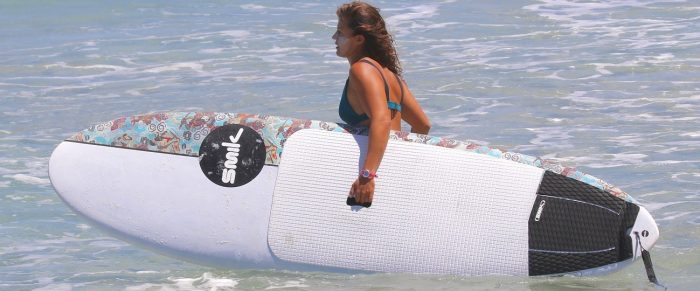
How to Easily Load a SUP Onto Your Car
If you’re feeling tired after paddling, this technique will help you easily load your SUP board onto the roof of any car. It is so energy efficient that even big, muscular guys use it because why strain yourself when there’s no need?!? Check out the simple video summary below made by our Stand Up Surf Shop crew coach Nicki and Silvia (both women under 170cm tall).
This technique is all about using your head, literally!

How Small Is too Small?
So the question is – how small can you go for it to be enjoyable, easy to handle and do what you want with it?
There are a number of elements that come into the equation when looking to down size your board. Such as what do you want out of this smaller board? Is it to make it more manoeuvrable in the surf, to go faster or even to make it easier to handle getting on and off the car.

Volume is important
Quite often people will talk about the ‘volume’ of boards. As you downsize the volume of the board, your body weight starts to become more relevant. All but the very top SUP surfers will generally need enough volume in a board to float themselves, ie, the board volume in litres is bigger than what they weigh in kilograms.
Although volume is an indicator, it’s not the determining factor in deciding what board you should get. The new square style boards (Sunova Speed, Starboard Hypernut, SMIK Short Mac) are all great examples of where the volume is, rather than what it is, being the key. How these boards get so much stability at a relatively low volume level is through having a higher percentage of board in direct contact with the water. Ultimately it doesn’t matter if you are on a 400L board – if 95% of it is out of the water, it isn’t going to be stable.
Come into the shop – we’re always happy to have a chat and a coffee to help you work out what will suit you best.

Width gives you stability
A major factor to consider when downsizing is to make sure you keep width. Width is what gives you stability. And it’s important to just take a small step at first or work it our with our free demos. There is a BIG difference between a board that is 31” and 29”. It may not sound like much – only 2” – but that can make a huge difference in how stable the board is and how it performs.
Here is the balancing point when it comes to width. Wider will generally mean slower and less manoeuvrable. However go too narrow and you spend more time and energy trying to just stay upright on the board rather than actually paddling.

Choosing the right length
Inherently, a longer board is going to be quicker. However if that board is TOO BIG, then it will actually be detrimental to going faster as the paddler will have to move something bigger through water. So getting a board that is size appropriate for the paddler and what they want to do with it is the ultimate goal.

How do we achieve this goal? Demo, demo, demo.
Try big. Try small. Try different combinations of length and width to see what feels good. By utilising our free demo boards which are available 7 days a week for you to take away and paddle in the conditions you would normally paddle in. Then giving our staff feedback on each board, we can then either suggest something else that will tick a certain box for you or if you have found the right one, pick a brand new one of the shelf for you.
*Think twice about buying a board with the idea of “growing into it”. Especially if you’re doing this sport because you enjoy it, not because it is hard work. As humans, if we don’t enjoy something we won’t do it or use it.*






